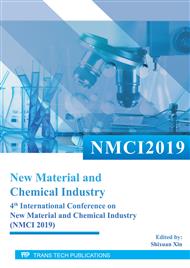p.135
p.145
p.153
p.160
p.168
p.174
p.182
p.186
p.193
Study of Dielectric Characteristics and Energy Storage Properties of Sr0.7Bi0.2TiO3 Doped with CaTiO3
Abstract:
Sr0.7Bi0.2TiO3 (SBT), a kind of lead-free relaxor ferroelectric, is attracting more and more attention for pulse energy storage applications due to the low remnant polarization and high energy storage efficiency (h). However, relatively low dielectric breakdown strength (DBS) limited the recoverable energy storage density (Wrec). Herein, CaTiO3 with high intrinsic DBS was introduced in SBT. The novel solid solutions (1-x)SBT-xCT with x = 0 - 0.15 shows pure pseudo-cubic perovskite structure. When x = 0.05, the maxium polarization are improved, and the CT doping decreases the average grain size, leading to an enhanced DBS. A high energy storage properties of 1.59 J/cm3 with the h of 87.4% at 220 kV/cm is achieved in 0.95SBT-0.05CT, which demonstrates that this 0.95SBT-0.05CT is prospective materials for energy storage application.
Info:
Periodical:
Pages:
168-173
Citation:
Online since:
May 2020
Authors:
Price:
Сopyright:
© 2020 Trans Tech Publications Ltd. All Rights Reserved
Share:
Citation:


